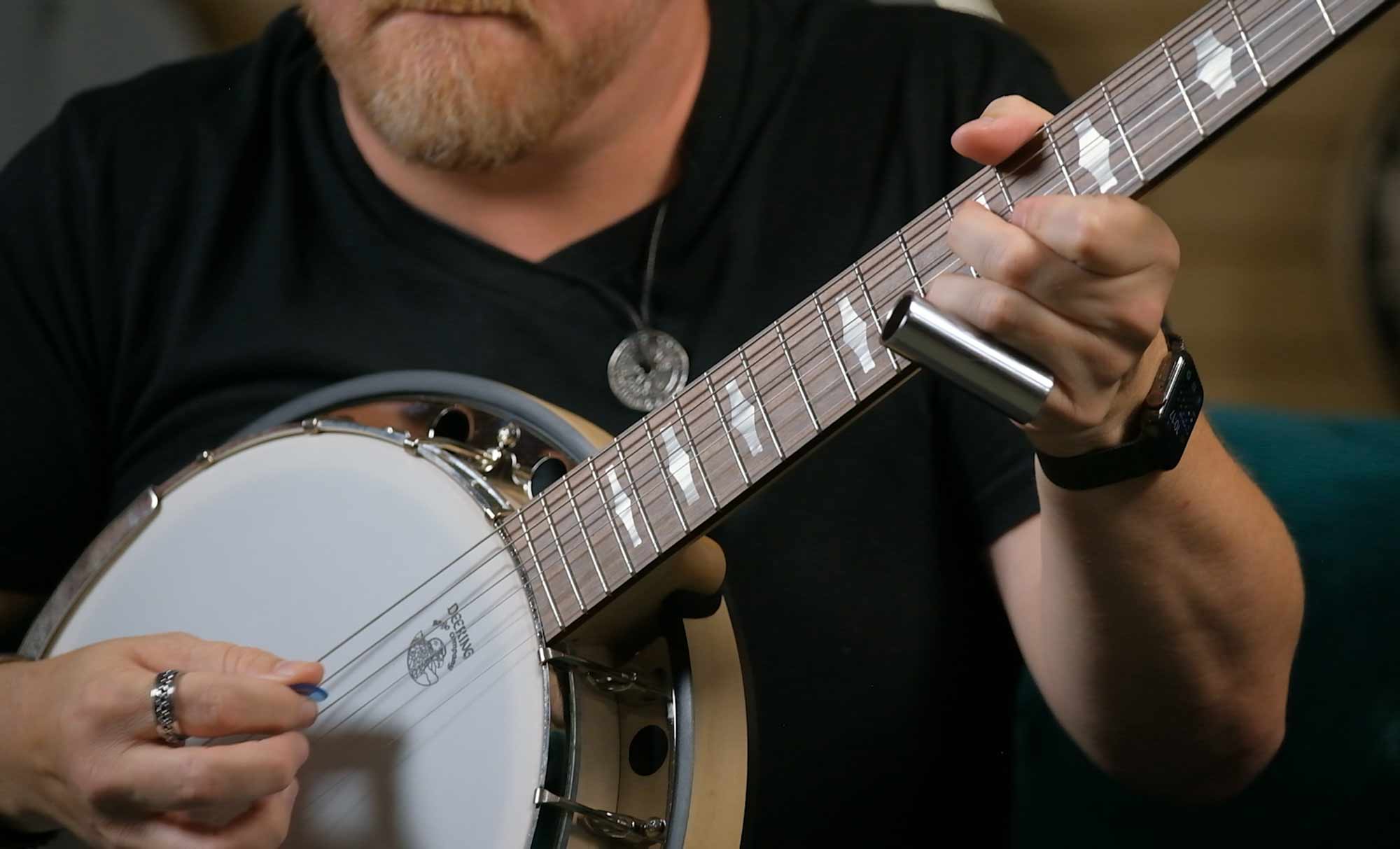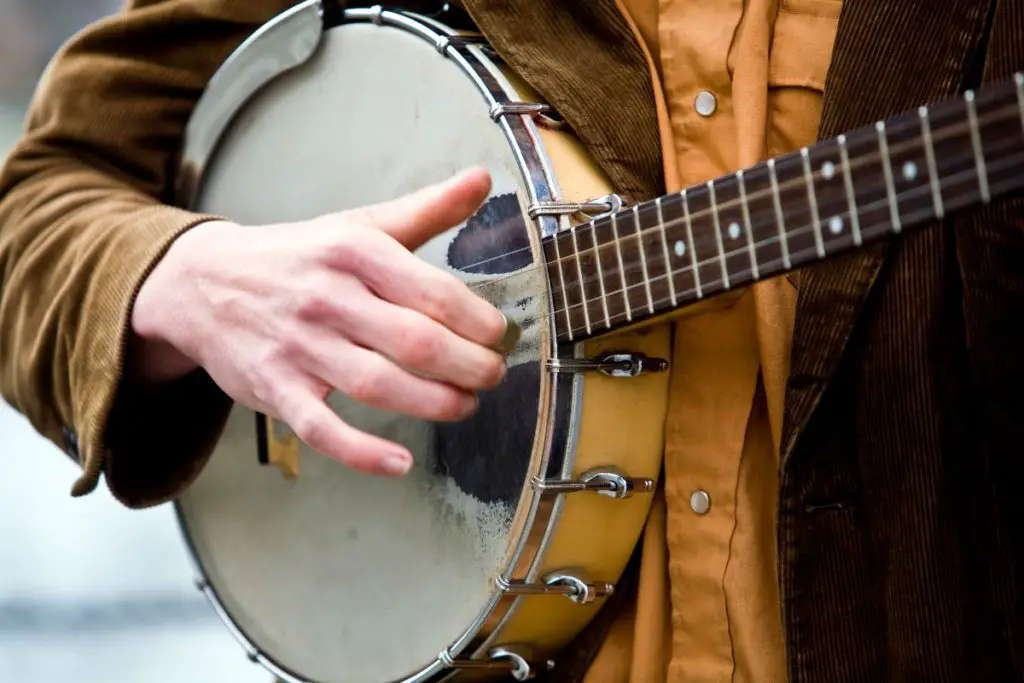 There are few things as quintessentially American as the image of a player sitting in a rocking chair on the front porch strumming on a banjo. One of the essential instrumental voices in American bluegrass, country, dixieland jazz, and folk music, the banjo is lots of fun to play, and mastering it can offer a lifetime of satisfaction. Its bright and articulate tone is relatively easy to produce, and the banjo’s percussive rhythms add bounce and drive to many different music styles. In its modern form, the banjo is one of the few purely native American instruments.
There are few things as quintessentially American as the image of a player sitting in a rocking chair on the front porch strumming on a banjo. One of the essential instrumental voices in American bluegrass, country, dixieland jazz, and folk music, the banjo is lots of fun to play, and mastering it can offer a lifetime of satisfaction. Its bright and articulate tone is relatively easy to produce, and the banjo’s percussive rhythms add bounce and drive to many different music styles. In its modern form, the banjo is one of the few purely native American instruments.Artists such as Béla Fleck have taken the banjo far beyond its musical roots by using it in classical, jazz, and fusion contexts. Modern acts including Mumford and Sons, The Carolina Chocolate Drops, and The Avett Brothers have helped rekindle interest in playing banjo among younger players. Where it was once thought of as a strictly hillbilly instrument, the banjo is enjoying newfound popularity today.
In this beginners’ guide, we will explore the essentials of playing the banjo, including choosing the right instrument, understanding its components, mastering basic techniques, exploring different playing styles, and finding resources for further learning.
The Banjo—A Brief History
The origins of the banjo as we know it are unclear. It has some resemblance to West African instruments such as the kora with its plucked strings and skin head stretched on a gourd body. But unlike the banjo, the kora has a stick neck and metal loops that function similarly to frets.
The earliest banjo-like instruments to turn up in the Americas also used a gourd for a body, animal skin for a resonator, and a simple stick neck. They had various numbers of strings that usually included one that produced a drone.
By the 17th century early prototypes of the modern banjo starting appearing in the Caribbean. These instruments with their fingerboards and tuning pegs showed the influence of other western stringed instruments.
These earliest versions of the modern banjo were played by slaves, and it wasn’t until the 1830s that a white Virginian minstrel musician, Joel Walker Sweeney, took up the instrument. His banjo had four full-length strings, a shorter fifth drone string, and had a drumhead-like body. The banjo soon developed an audience on both sides of the Atlantic as Sweeney took his minstrel act to England where his banjo became a staple of music-hall instrumentation.
The banjo enjoyed continued popularity beyond the minstrel era largely thanks to Charlie Poole and his trio, the North Carolina Ramblers. As the result of a baseball injury to his hand, Poole adopted a three-finger picking technique that’s become known as classic or finger-style banjo. With their bluesy fiddle and melodic and intricate guitar and banjo parts, the Ramblers and their popular 1920s records became a prototype for modern bluegrass. Influenced by Poole’s technique, fellow North Carolinian Earl Scruggs, the banjo player in Bill Monroe’s groundbreaking Blue Grass Boys, defined the sound of modern bluegrass banjo in the 1940s.
As various banjo playing techniques evolved, new forms of the instrument were developed as we’ll see.
Choosing the Right Banjo

Before diving into banjo playing, it’s crucial to select the right instrument for your needs and preferences. There are different types of banjos, including open-back, resonator, and electric banjos, each offering unique sounds and characteristics. Consider the playing style you’re interested in, your budget, and the type of music you want to play when choosing your banjo. It’s also essential to ensure that the banjo is well-constructed, properly set up, and comfortable to play.
Understanding the Banjo
To begin your banjo journey, it’s important to understand the instrument’s various components. The banjo consists of a circular body or pot, a neck, a head, tuning pegs, a bridge, and strings. Familiarize yourself with these parts and learn how they contribute to the sound and playability of the banjo. Additionally, familiarize yourself with the different types of banjo strings and the role they play in producing different tonal qualities.
Mastering Basic Techniques
Like any musical instrument, the banjo requires mastering fundamental techniques to produce beautiful music. Start by learning how to hold the banjo correctly, positioning your fingers on the fretboard, and using proper picking techniques. Practice playing single notes, then progress to simple chords and strumming patterns. Focus on developing a consistent rhythm and clean, clear notes. Patience and persistence are key during this stage, as it takes time to build muscle memory and develop finger dexterity.
Exploring Different Playing Styles
The banjo is renowned for its versatility and ability to be used across various music genres. Depending on your preferences, you can explore different playing styles such as bluegrass, old-time, folk, clawhammer, or fingerpicking. Each style has its distinct characteristics, techniques, and musical repertoire. Take the time to listen to banjo players from different genres to gain inspiration and insight into their unique playing styles. Experiment with different techniques and styles to find what resonates with you the most.
Finding Resources for Further Learning
Learning to play the banjo is an ongoing process, and there are numerous resources available to aid in your journey. Consider taking lessons from a qualified banjo instructor who can provide guidance, personalized feedback, and help you progress at a steady pace. Online tutorials, instructional books, and video lessons can also be valuable tools to supplement your learning. Additionally, joining banjo forums, attending workshops, and connecting with other banjo enthusiasts can provide a supportive community and opportunities for growth.
Final Thoughts
Learning to play the banjo is an exciting and fulfilling endeavor that can open up a world of musical possibilities. By choosing the right banjo, understanding its components, mastering basic techniques, exploring different playing styles, and utilizing available resources, you can embark on a rewarding banjo journey. Remember to practice regularly, maintain a positive mindset, and enjoy the process of discovering new melodies and rhythms. With dedication and passion, you’ll soon find yourself strumming and picking your way to becoming a skilled banjo player.
Frequently Asked Questions
I want to play Irish Music, what type of banjo is right for me?
Answer: Irish music can be played on both the 4-string tenor banjo and 5-string banjo. The most popular banjo for playing tunes and irish dance music eg. Jigs, Reels, Polkas etc. is a 4-string tenor banjo. A 5-string banjo can be chosen to accompany folk songs in the folk style. You can strum along to songs or you can play it in the ‘melodic style’ with finger picks
I want to play Bluegrass Music, what type of banjo is right for me?
Answer: The choice of banjo for playing Bluegrass music is the 5-string banjo. You will play it in the ‘Three Finger Scruggs style’ with two metal finger picks and a plastic thumb pick. A banjo fitted with a resonator is the choice of most bluegrass players as the resonator will give you the hardest driving banjo and the most volume.
I want an American made banjo, which brand should I choose?
Answer: You can choose from USA built Deering Banjos, OME Banjos, Stelling Banjos and Nechville Banjos. Also consider the superb quality of Prucha Banjos made in the Czech Republic. Each one of these World Class brands has its own unique features and characteristics within its range of banjo models. It can be said that Deering is the best choice for quality relative to price in USA banjos due to the efficiency of its state-of-the-art modern banjo factory in San Diego, California, USA where Greg Deering leads a team of fine banjo craftsmen hand finishing each instrument that they build.



